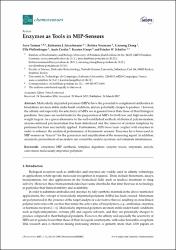| dc.contributor.author | Yarman, Aysu | |
| dc.contributor.author | Jetzschmann, Katharina J. | |
| dc.contributor.author | Neumann, Bettina | |
| dc.contributor.author | Zhang, Xiaorong | |
| dc.contributor.author | Wollenberger, Ulla | |
| dc.contributor.author | Cordin, Aude | |
| dc.contributor.author | Scheller, Frieder W. | |
| dc.date.accessioned | 2021-01-08T21:51:25Z | |
| dc.date.available | 2021-01-08T21:51:25Z | |
| dc.date.issued | 2017 | |
| dc.identifier.issn | 2227-9040 | |
| dc.identifier.uri | http://doi.org/10.3390/chemosensors5020011 | |
| dc.identifier.uri | https://hdl.handle.net/20.500.12846/247 | |
| dc.description | Wollenberger, Ulla/0000-0002-7088-8928 | en_US |
| dc.description | WOS:000404532700001 | en_US |
| dc.description.abstract | Molecularly imprinted polymers (MIPs) have the potential to complement antibodies in bioanalysis, are more stable under harsh conditions, and are potentially cheaper to produce. However, the affinity and especially the selectivity of MIPs are in general lower than those of their biological pendants. Enzymes are useful tools for the preparation of MIPs for both low and high-molecular weight targets: As a green alternative to the well-established methods of chemical polymerization, enzyme-initiated polymerization has been introduced and the removal of protein templates by proteases has been successfully applied. Furthermore, MIPs have been coupled with enzymes in order to enhance the analytical performance of biomimetic sensors: Enzymes have been used in MIP-sensors as tracers for the generation and amplification of the measuring signal. In addition, enzymatic pretreatment of an analyte can extend the analyte spectrum and eliminate interferences. | en_US |
| dc.description.sponsorship | Deutsche Forschungsgemeinschaft (DFG) within the framework of the German Excellence Initiative UnicatGerman Research Foundation (DFG) [EXC 314]; ERA-Chemistry [61133]; Turkish-German University Scientific Research Projects Commission [2016BF0011]; European Union FP7 Marie Curie programme (CHEBANA)European Union (EU) [PITN-GA-2010-264772]; Regional Council of Picardy (BIOMIP project) | en_US |
| dc.description.sponsorship | The authors gratefully acknowledge financial support from Deutsche Forschungsgemeinschaft (DFG) within the framework of the German Excellence Initiative Unicat (EXC 314), ERA-Chemistry (2014, 61133), and Turkish-German University Scientific Research Projects Commission under the Grant No. 2016BF0011 for financial support. KH and AFC acknowledge the European Union FP7 Marie Curie programme (CHEBANA, PITN-GA-2010-264772) and the Regional Council of Picardy (BIOMIP project) for funding. | en_US |
| dc.language.iso | eng | en_US |
| dc.publisher | Mdpi | en_US |
| dc.rights | info:eu-repo/semantics/openAccess | en_US |
| dc.subject | Enzymatic Mip Synthesis | en_US |
| dc.subject | Template Digestion | en_US |
| dc.subject | Enzyme Tracer | en_US |
| dc.subject | Enzymatic Analyte Conversion | en_US |
| dc.subject | Molecularly Imprinted Polymers | en_US |
| dc.title | Enzymes as tools in MIP-Sensors | en_US |
| dc.type | Review | en_US |
| dc.relation.journal | Chemosensors | en_US |
| dc.identifier.volume | 5 | en_US |
| dc.identifier.issue | 2 | en_US |
| dc.relation.publicationcategory | other | en_US |
| dc.contributor.department | TAÜ, Fen Fakültesi, Moleküler Biyoteknoloji Bölümü | en_US |
| dc.contributor.institutionauthor | Yarman, Aysu | |
| dc.identifier.doi | 10.3390/chemosensors5020011 | |
| dc.identifier.wosquality | N/A | en_US |
| dc.identifier.scopusquality | Q2 | en_US |

















